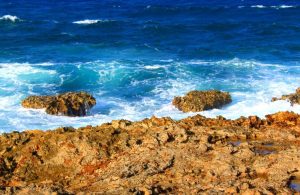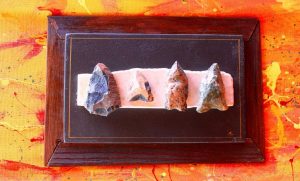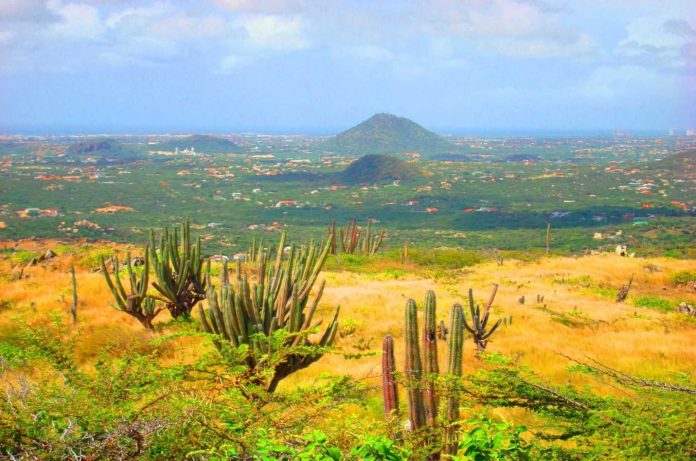We can differentiate three basic geological formations in Aruba. One is a hilly part, second an undulating part and a third part consisting of limestone which embraces these two zones forming also the coast line.
The central hilly part is where you can find the highest elevations of the island. The highest point is called Yamanota 189m and most of the other hills, like Arikok 184m which is also situated in the central part of the island. This landscape is of rock unit and called the Aruba Lava Formation in geological terms.
This rock unit has two main components, volcanic rock and metamorphic rock. The hills are made up of the resistant volcanic rocks. The most common of these rocks is diabase, a hard, black rock. Diabase, also called dolerite, is a fine- to medium-grained, dark gray to black intrusive igneous rock. It is extremely hard and tough and is commonly quarried for crushed stone, under the name of trap.
The metamorphic rock, schist, is a less hard, green rock with a sheet-like structure. The parts of the Aruba Lava Formation landscape which consist of schist are the less resistant to the elements. Metamorphic rocks started out as some other type of rock, but have been substantially changed from their original igneous, sedimentary, or earlier metamorphic form. Metamorphic rocks form when rocks are subjected to high heat, high pressure, hot mineral-rich fluids or, more commonly, some combination of these factors.
Pre historic Arubans: The rocks of the Aruba Lava Formation were extensively used by the inhabitants of our island. The physical characteristic of the rocks played a key role in determining the purpose for which it would be used. Diabase was used to make axes, chisels, knives and the polishers. The hardness and the homogeneous structure of the rock make it the best raw material for these artifacts available on the island. The polishers were collected at the bay`s on the northern coast and were then further polished. Amerindians of the mainland make similar artifacts. The schist was used as material to make pendants and beads; the green color was probably the determining factor. No tools of schist has been found, the sheet-like structure is a limiting factor when making an axe or chisel. The rock will easily split along the sheet-lines. The rock type of similar beads and pendants found in the area_ and described in the literature as greenstone_ is often difficult to establish since the term greenstone covers a wide range of different rock types like schist as we mentioned, rhyolite and jade.
The quartz diorite landscape (org; batholith) from the central part of Aruba towards the west and northwestern end of the island, and from the central part towards the east and south, is a rock clusters with the main component being quartz diorite. The landscape here is flat to slightly undulating with quartz diorite boulders coming out of it. This rock is black and white speckled. It is relatively hard. The typical diorite landscape is found near Santa Cruz. These are all areas with boulders with small or large patches of sand and vegetation in between. Other places with boulders and large areas of quartz diorite debris are found in the east in Tanki Flip, Noord, Alto Vista and in the south in Savaneta. q
To get to know more about Aruba and its origins, its animals and culture, we highly recommend you to book our cultural encounter session which is mind opening and entertaining curious hearts for decades already. Mail us at etnianativa03@gmail.com.

















